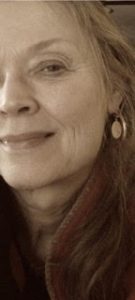dl mattila

dl mattila
Oakton, Virginia
soft pedaling
our differences
cherry blossoms
Congratulations on having your haiku selected as the top winner in the United States category in the Vancouver Cherry Blossom Festival’s 2016 Haiku Invitational contest. How did you first learn about haiku, and how much writing of haiku or other poetry have you done?
Thank you so much! I’m overwhelmed and honored to think others would consider my work worthy of such recognition. In regard to how I came to haiku, I’ve always been drawn to the work of the Imagist poets, so I suppose interest in haiku is due in large part to my appreciation for concise expression. I remember discovering Ezra Pound’s “In a Station of the Metro” and thinking how expressive it was in its brevity. Soon thereafter, my literary wanderings led to the haiku world and its community of incredibly gifted writers. It didn’t take long, however, to realize I held naive notions about haiku, which then led to an intense search for resources that would enhance my understanding of the genre. Although my graduate work provided a firm foundation in formalist poetry, my interests since 2015 have centered around Japanese short-verse forms. I’ve been fortunate to have some of my work published.
What was the inspiration for your winning poem?
There were two vastly different images that influenced what I eventually wrote, but I began, as I often do, where the thrum of daily life fades into the background as the mind drifts amidst a panoply of visual imagery. Initial imagery centered around throngs of people of differing ethnic, linguistic, and religious backgrounds—strolling together as one—beneath cherry trees bursting with spectacular yet transient blooms symbolizing hope, friendship, and life’s fragility. But subsequent imagery, perhaps heavily influenced by the fact that I live in a richly hued multicultural environment, was starkly different. Juxtaposed against the serenity of the sakura trees was the imagery of oppressed people, immigrants and refugees in the United States and abroad who find themselves searching for acceptance. They live in often hostile environments that seek to underscore and exploit differences instead of embracing our common humanity. I struggled over how to communicate my visceral reactions to such indignities and wondered where, in times such as these, one might discover a measure of solace.
Describe the moment when you first learned you had won.
Initially, it didn’t register that my entry was the winning U.S. entry. When I received the congratulatory email, I was thrilled to think I was one among a number of writers whose work had been singled out for recognition. I was taken aback when I realized mine was the one. Immediate family members were the first to know. They’re my front-line responders.
Do you have favourite books or websites relating to haiku that others might benefit from in order to learn haiku as a literary art and to share one’s haiku?
I do! To begin with, the Internet is a remarkable resource for those wishing to learn more about haiku as a literary art. I frequent many websites and constantly read and study the work of haiku poets in North America. Print and online literary journals in the United States such as Acorn, Frogpond, Modern Haiku, The Heron’s Nest, and others regularly publish poets whose work rises to a level of expertise worthy of recognition. Two additional publications I find delightful are Bones and Tinywords. In addition to these resources, the Haiku Society of America and Haiku Foundation websites offer a wealth of information to anyone interested in learning more. The Haiku Foundation website even includes a Haiku Registry of pictured poets along with samples of their work. For in-depth and insightful tutorials, I highly recommend Jane Reichhold’s AHA Poetry website. As far as books are concerned, there are many, but a few resources I value include Richard Gilbert’s The Disjunctive Dragonfly, Lee Gurga’s Haiku: A Poet’s Guide, and Haiku in English: The First Hundred Years, edited by Jim Kacian, Phillip Rowland, and Allan Burns.
Please tell us more about yourself.
By profession I’m an educator and a linguist. As an educator I’ve worked with deaf and hard-of-hearing children, young adults, and senior citizens. As a linguist/interpreter I facilitate interactions between visual language and spoken language users. The Greater Washington DC Metropolitan Area is an especially interesting/challenging venue for interpreters as many deaf professionals (activists, doctors, lawyers, government program managers, and educators) expect interpreting services commensurate with their levels of education. I’ve recently taken a step back from full-time employment to focus more of my efforts on writing. I returned to grad school in 2009 to pursue an MA in writing (poetry) and completed my work in 2012. I travel extensively, relish immersion in cultures other than my own, am married with two adult children, and coexist with a mannequin—an objet trouvé—in my dining room.
How does where you live and what you enjoy doing affect the way you write haiku?
I reside in a densely populated urban area, so much of what I write reflects daily observances of human activity and interaction. My profession is undoubtedly an influencing factor. Effectiveness as an interpreter depends upon an ability to detect nuance in verbal and nonverbal communication, so I suspect my observational skills serve me well in identifying moments of significance. Yet I find conveying those moments of significance—in the form of a successful haiku—to be quite challenging. What may appear simplistic is in fact a multifaceted, highly concise, literary art form that demands a great deal from the writer. Nevertheless, I find it all so rewarding.

